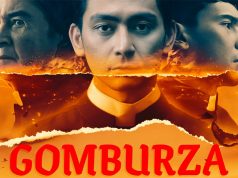Somewhere in “Deadma Walking,” one gem of an entry in this year’s Metro Manila Film Festival, you will find yourself, or remember someone who has dealt with life with as much zest and vigor as the free-spirited Mark (Edgar Allan Guzman in top form), or think of someone who has loved as selflessly as John (a splendid Joross Gamboa).
For a film that deals with death, friendship, unrequited feelings, strained bonds, and the certainty and uncertainty of our mortality, “Deadma Walking” is a three-hankie – no, make that five-hankie — full length feature that is ultimately life-affirming.
Designed as a delightful romp, “Deadma Walking” is a fun exploration of every one’s most whispered-about fear. What if we are suddenly told that our days are numbered?
Defiant, young entrepreneur John decides to put one over the Grim Reaper. He hatches a plan and seeks the help of his best friend Mark, a part-time theater actor to pull it off.
And yet, on closer scrutiny, “Deadma Walking” is ostensibly a comedy but one that makes you smile through your tears. In Tagalog, ‘yung tipong mangingiti ka pero masakit. It is a lovely film from a Palanca award-winning script by Eric Cabahug that is laced with moments of subtle drama, high art (black and white French films, anyone?), and little ironies.
Speaking of ironies. Watch for a scene towards the end where the disparities between a fake wake and a real one come to fore — one is no to “saklaan” and “tong-its” and yes to buffet which is the exact opposite of the other.
Yes, there are parts that are a little rough around the edges, but the film is told coherently and engagingly. At a time when movies often come on too strong with “big messages” wrapped around them, “Deadma Walking” is a throwback to the days when films, the really good ones, were easy to decipher and yet retained certain mysteries for viewers to discover for themselves. And whose many hidden layers will make film buffs engage in a discourse in the years to come.
There are, of course, the more attention-getting scenes but what we love best about it are the quieter moments, like shooting stars that might easily escape the eye. Such as that scene where Joross as John, disguised as transgender Yolly Redgrave, and the great love of his life cross paths literally in the former’s fake wake, and John, at the sight of the one that got away, cannot look away and grabs at a chair, his knees suddenly wobbly.
Joross Gamboa’s John is a staggering achievement, a portrayal filled with lovely nuances and gestures. To the untrained eye, it is easy to miss out on the details of Joross’ performance because basically his role calls for him to be more reserved, with lesser and smaller movements. Those who know the actor personally swear that the real Joross is anything but reserved. To watch him transform into a sophisticated gay man is quite a sight to behold.
It is a tricky challenge since emotions have to be conveyed mostly through the eyes. Take note of the scene where the actor who plays Luke, Joross’ character’s one great love, delivers a eulogy and Joross as John only lifts his big, dark glasses a little and as he listens to the tribute, tears slowly gather in his eyes but do nto actually fall.
Or that montage at the start of the movie where he goes through the motions of his routinary existence, but this time after having been told that he has but more than a year tops to live. Not a word is spoken but Joross runs the gamut of emotions experienced by someone who has just learned that his days are numbered.
Notice also how even with his back to the camera, you can tell at once that he is a gay man by the way he stands, carries himself around, walks. The merest inflections in the voice. The very gait. Joross Gamboa becomes John Samson and isn’t that the foremost hallmark of a beautiful performance?
Matching Joross every step of the way is Edgar Allan Guzman as the more flamboyant Mark. His is a character with outsized emotions, one who literally broke through the closet. He is out, proud, and loud. And Edgar Allan strikes not a false note, fully inhabiting the role. He shrieks, he loves, he performs, he seethes, he sizzles.
Ably guided by debuting director Julius Alfonso, the actor comes up with a well-tuned performance, easily shifting into a more introspective attack, especially in that scene where Joross or his “spirit” is trying to have a conversation with his sister (an affecting Dimples Romana) from whom he has been estranged. Edgar Allan knows that it is Joross’ scene and so he hands it to him, merely stands behind him, almost in the dark, but his eyes grow misty hearing the heartbreaking exchange between the siblings.
In “Deadma Walking,” Joross Gamboa and Edgar Allan Guzman are like yin and yang precisely because they complement each other, their chemistry palpable that you believe that they are really “beshies” (or “mag-migs,” short for “amigas”). And it all works also because the parts are both well-written, screenwriter Cabahug wisely making the delicate choice to make the characters polar opposites.
The script is equal parts funny and observant translated wonderfully to the big screen by first-time director Julius Alfonso who has done a long apprenticeship as assistant director to many other filmmakers. Alfonso handles the material with care, attention to detail, and gusto.
By film’s end, one realizes that “Deadma Walking’s” underlying theme, and we are guessing here, is that life, no matter how short or long, is beautiful and to live is to make every moment matter. It can range to as simple as an idyll by the beach or binging on arthouse films to as plain idiosyncratic as sneering at death by planning your own faux passing.
To borrow extended time is to make your exit as fab and grand as you can muster.
Produced by T-Rex Entertainment, “Deadma Walking” opens December 25 in theaters nationwide.










